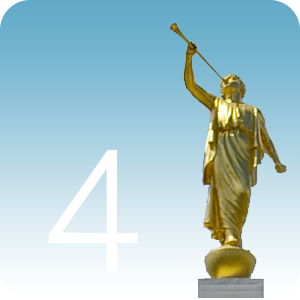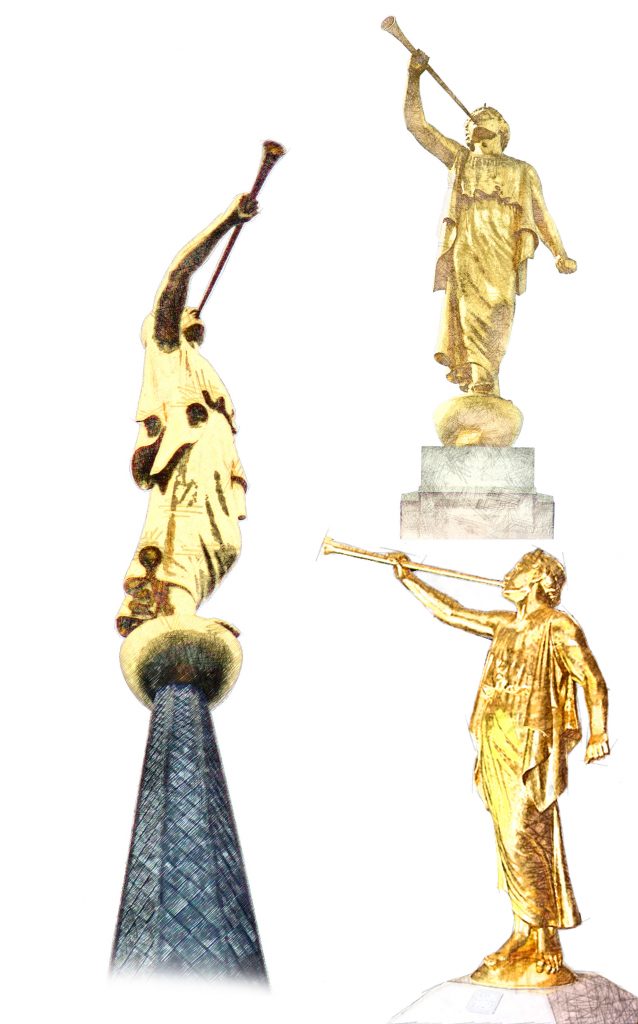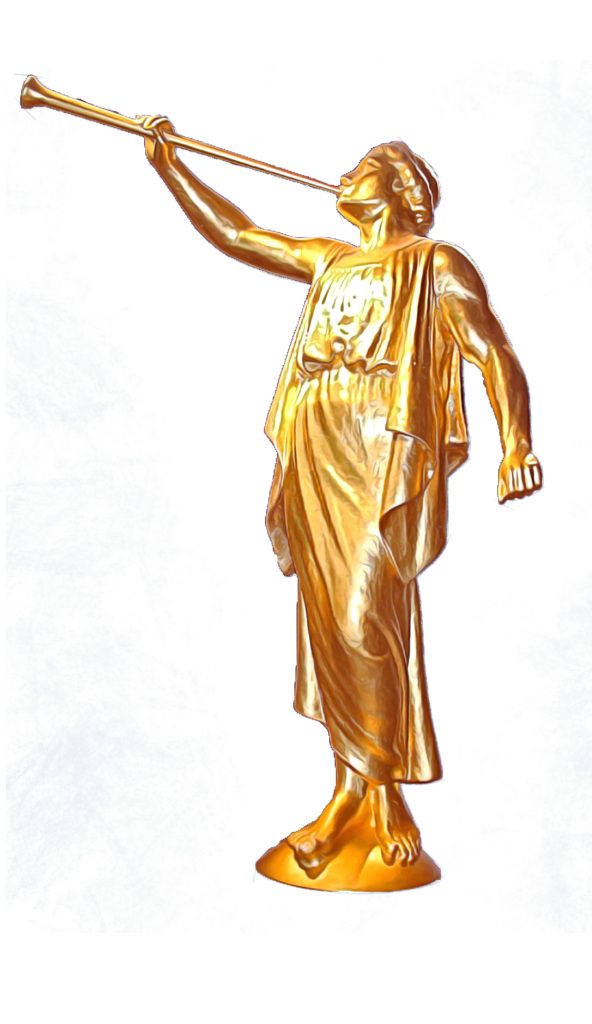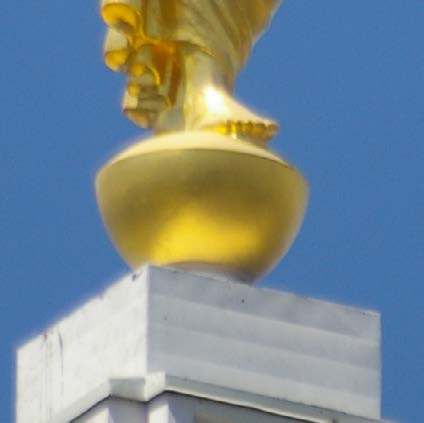
V1
COMMISSIONED
1930
MATERIAL
Welded Aluminum covered 22 karat gold leaf
HEIGHT
11’ 6” (3.5 Meters)
WEIGHT
645 lbs. (292.6 kilograms)
CURRENTLY ON
2nd floor, Church History Museum
V2
COMMISSIONED
~1980
MATERIAL
Fiberglass covered in 23-carat gold leaf
HEIGHT
11’ 6” (3.5 Meters)
WEIGHT
400lbs (181.44 kilograms)
CURRENTLY ON
2 Temples

A New Way to Statue
DC Chapel Statue
In the early 1930’s the Church constructed a chapel in Washington D.C. It was the first Chapel for the nation’s capital. The design called to mind the complexity and style of the Salt Lake Temple. As part of the design, a replica of the Salt Lake Angel Moroni was commissioned.[1]Reed Russell “Guest Post: The Washington, D.C. Chapel” keepapitchinin.org, 26 September 2012.
Torlief Knaphus designed the statue based on Cyrus Dallin‘s Moroni. This statue is a foot shorter than Dallin’s original. It’s 11’ 6” in height, and cast in aluminum. The statue weighs 645 lbs.[2]J. Michael Hunter “I Saw Another Angel Fly” Ensign, January 2000.
Fate of the Statue
The chapel was sold in 1976, and the statue was removed from the chapel and put in storage. That statue is currently in possession of the Church History Department. It is on display at the Church History Museum in Salt Lake City. It has never been placed on a temple.
There is a tradition that prior to ending up in the Church History Museum, this statue was briefly in the possession of the Church’s Motion Picture Studio. There is no official documentation anywhere indicating that this is in fact what happened.
The Motion Picture studio does have a fiberglass statue in its possession as of writing. This statue may have caused people to believe it was the DC Chapel statue due to its similarity in style. However, the Knaphus Statue is aluminum, not fiberglass.
The Need
In the early 1980’s there were 20 temples in existence, and of those 20, only five had Angel Statues. The first ever global push to bring the temples closer to the people had just begun. Seven temples had been announced in a press conference 2 April 1980. These new temples were to be in South America, Australia, Pacific Islands, and Southern United states.[3]Hart, John L, “7 new temples to be erected,” Church News, 5 April 1980, p. 3. The Church had never experienced such a rapid expansion in Temples before. To top that, another nine temples were added to the plan the following year in the United States, Europe, Asia and Africa.[4]“Plans announced for 9 new temples,” Church News, 4 April 1981, p. 3.
[gphotos type=”rectangular” ids=”1801″]The Atlanta Georgia Temple, first temple to have a fiberglass statue, had a replica of the Knaphus statue from 1982-1997
These new temples were smaller and more cost effective to build. As part of the cost cutting efforts, initial plans left off the traditional spire. In the end the decision was made to include not just a spire but an angel statue as well.[5]January 10, 1982, Church architect Emil B. Fetzer announced revised plans for the temple, via churchofjesuschristtemples.org This was done partly to make them easily identifiable as a temple, rather than a chapel, as most of them would be little larger than the chapels the Church would be building at the time.[6]Observation based upon satellite image calculations. [7]Roe, Frederick Robert 1920-. Angels: Moroni and his associates/Fred Roe [Bountiful, Utah]: The Author, 1992 May 1992 printing, (accessed: August 12, 2019)
Another reason for the inclusion was an understanding on the part of the Brethren of ‘branding.’ Giving the temple a statue, like the one in Salt Lake, atop the spire, would not only make them easily identifiable as Temples, but would cause people to ask questions about the statue, and in turn the Church. This new focus on identity would cause statues to be added to all temples for decades to come. [8]Roe, Frederick Robert 1920-. Angels: Moroni and his associates/Fred Roe [Bountiful, Utah]: The Author, 1992 May 1992 printing, (accessed: August 12, 2019)
There was, however, a structural problem with the desire to add statues to the new temple. These new small temples had narrow, sometimes delicate looking spires, incapable of holding the massive weight, 1.500 – 6,000 pounds each, of the Angels that had been produced in the past. Making the spires larger would cause the spire to be disproportionately large, not fitting well with the simpler size and elegance of the new designs, in addition to increasing the cost of the construction of the temple. Making a metal statue small enough to be held by these delicate spires would make them too small to be seen effectively. As a result, a new type of statue was needed. One that could retain the size and proportion needed to look nice atop the spire, but keep the weight down.
Such a statue had been made just a couple of decades earlier by Elbert Porter. He had made an 8 foot tall statue out of fiberglass, weighing only 200 pounds for the Mormon Pavilion at the 1964 World’s Fair. Such a statue was perfect for these new temples. The only hurdle left to be cleared was a method to rapidly produce multiple copies of statues for the first 7 of these temples.
The Commission – The Lighter Statue
[gphotos type=”rectangular” ids=”6209″]The Idaho Falls Idaho Temple received the second copy of the test statue in 1983. The statue has since been refurbished and is still atop the temple.
Karl Quilter and his friend LeVar Wallgren had been developing just such a method for reproducing sculptures and statues. This new method was hybrid of the techniques Quilter had learned from Richard Young and Avard Fairbanks, the polyester fiberglass materials Karl had learned to work with while working for a plastics shop after his mission,[9]Roe, Frederick Robert 1920-. Angels: Moroni and his associates/Fred Roe [Bountiful, Utah]: The Author, 1992 May 1992 printing, (accessed: August 12, 2019) and the techniques and materials Wallgren had learned while working with fiberglass in a boat yard.[10]”Statues Sculpted in fiberglass,” Church News, 4 September 1983, p. 4.
Prior to the Angels, the pair first did a different job for the Church, where in they created new spires for the Assembly Hall at Tabernacle Square. This job required the creation of 22 new spires in two different kinds. On each of the four gables of the hall are three each octagonal spire tops, for a total of 12 octagonal towers. On the North and South sides of the assembly hall were five spires on each side with four-sided spire tops, for a total of 10. The team of Wallgren and Quilter were able to successfully produce all 22 spires in good time and with a high level of detail per spire.[11]”New Spires Brighten Old Hall,” Church News, 18 July 1981, p. 10. [12]Roe, Frederick Robert 1920-. Angels: Moroni and his associates/Fred Roe [Bountiful, Utah]: The Author, 1992 May 1992 printing, (accessed: August 12, 2019) This particular job led to Brother Wallgren’s company producing spires for chapels all over the world.
The Test
To show what they could produce statues as well, Brother Wallgren used the Washington D.C. Chapel Statue as a guide for a test of a new type of Angel Moroni Statue. The Chapel statue, previously sculpted by Torlief Knaphus had been retired and removed from its spire perch just a few years prior. Wallgren made a mold from the chapel statue,[13]Roe, Frederick Robert 1920-. Angels: Moroni and his associates/Fred Roe [Bountiful, Utah]: The Author, 1992 May 1992 printing, (accessed: August 12, 2019) and from it reproduced 2 copies of the statue using the new Fiberglass composition method he and Quilter had produced.
This method was very successful, and Quilter and Wallgren would use it to make not just the Angel Status, but in many cases the oxen and font for the temples baptistry.[14]“LDS Sculptor Leaves Lasting Legacy” LDS.org, 5 December 2013 The new sculptures were so durable and resilient that Wallgren believed they would go decades before needing replacements.[15]”Statues Sculpted in fiberglass,” Church News, 4 September 1983, p. 4.
The Idaho Falls statue remains, but the Atlanta Statue was removed, replaced with another model. This original statue was destroyed after removal.[16]Mike Enfield, phone interview with Marvin Quist. The reason for its destruction is unknown, but it was possibly due to damage received during its 14 years atop the temple spire. A third copy of this statue was later cast for the Boston Massachusetts Temple [17]Mike Enfield, phone interview with Marvin Quist. and was placed 1 September 2001. This recreation of the Dallin Statue is on the temple closest to the Arlington Massachusetts home where Dallin lived for most of his life.
[gphotos type=”rectangular” ids=”2995″]One year after its dedication, a third copy of this statue, one of only two still in use, was placed atop the Boston Massachusetts Temple.
Knaphus vs Dallin
While from a distance Knaphus’s statue looks identical to the Salt Lake Temple statue, there are differences between the two. In regards to his sculpture, Knaphus said that the arms and shoulders are “beefier” than the original. Other differences include the following:
| Dallin | Knaphus | |
| Cap | No perceptible band | Visible band around back of head |
| Eyes | Lids partially closed, eyes staring at horn | Lids wide open, eyes look up |
| Cheeks | Cheeks puffed | Cheeks relaxed |
| Lips | Mouthpiece against lips | Mouthpiece in lips |
| Face | Young | Older |
| Trumpet Bell | Horn flares out abruptly | Horn flares less severely |
| Trumpet Tube | Thinner | Thicker |
| Arms | Slightly longer, less muscle tone | Slightly longer, less muscle tone |
| Hands | Thinner, more feminine | Thicker, more muscled |
| Feet | Longer | Shorter |
| Toes | Curve upward little toenail detail | Curve down over ball, outlined toenails |
Identification Guide


The Unique Sphere
Standing on the same gold disc, as the Dallin Statue, this statue has a smaller half sphere matching the outer edge of the disc, giving a look of a gold bowl with a lid atop it
Chapter 3 Navigation
Related Articles
Torlief Knaphus →
Every Temple Gets a Moroni →
References
| ↑1 | Reed Russell “Guest Post: The Washington, D.C. Chapel” keepapitchinin.org, 26 September 2012. |
|---|---|
| ↑2 | J. Michael Hunter “I Saw Another Angel Fly” Ensign, January 2000. |
| ↑3 | Hart, John L, “7 new temples to be erected,” Church News, 5 April 1980, p. 3. |
| ↑4 | “Plans announced for 9 new temples,” Church News, 4 April 1981, p. 3. |
| ↑5 | January 10, 1982, Church architect Emil B. Fetzer announced revised plans for the temple, via churchofjesuschristtemples.org |
| ↑6 | Observation based upon satellite image calculations. |
| ↑7 | Roe, Frederick Robert 1920-. Angels: Moroni and his associates/Fred Roe [Bountiful, Utah]: The Author, 1992 May 1992 printing, (accessed: August 12, 2019) |
| ↑8, ↑9 | Roe, Frederick Robert 1920-. Angels: Moroni and his associates/Fred Roe [Bountiful, Utah]: The Author, 1992 May 1992 printing, (accessed: August 12, 2019) |
| ↑10, ↑15 | ”Statues Sculpted in fiberglass,” Church News, 4 September 1983, p. 4. |
| ↑11 | ”New Spires Brighten Old Hall,” Church News, 18 July 1981, p. 10. |
| ↑12 | Roe, Frederick Robert 1920-. Angels: Moroni and his associates/Fred Roe [Bountiful, Utah]: The Author, 1992 May 1992 printing, (accessed: August 12, 2019) |
| ↑13 | Roe, Frederick Robert 1920-. Angels: Moroni and his associates/Fred Roe [Bountiful, Utah]: The Author, 1992 May 1992 printing, (accessed: August 12, 2019) |
| ↑14 | “LDS Sculptor Leaves Lasting Legacy” LDS.org, 5 December 2013 |
| ↑16, ↑17 | Mike Enfield, phone interview with Marvin Quist. |
